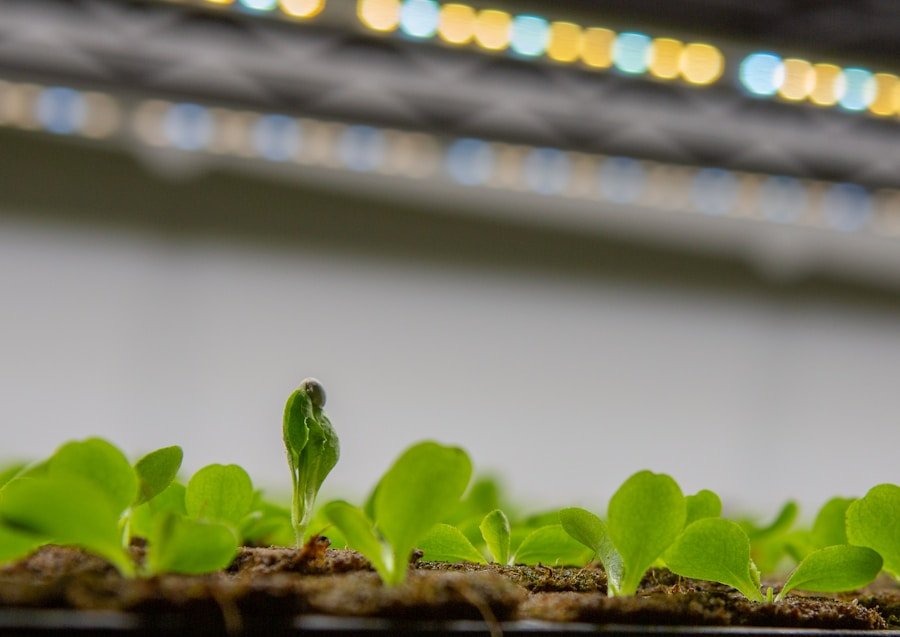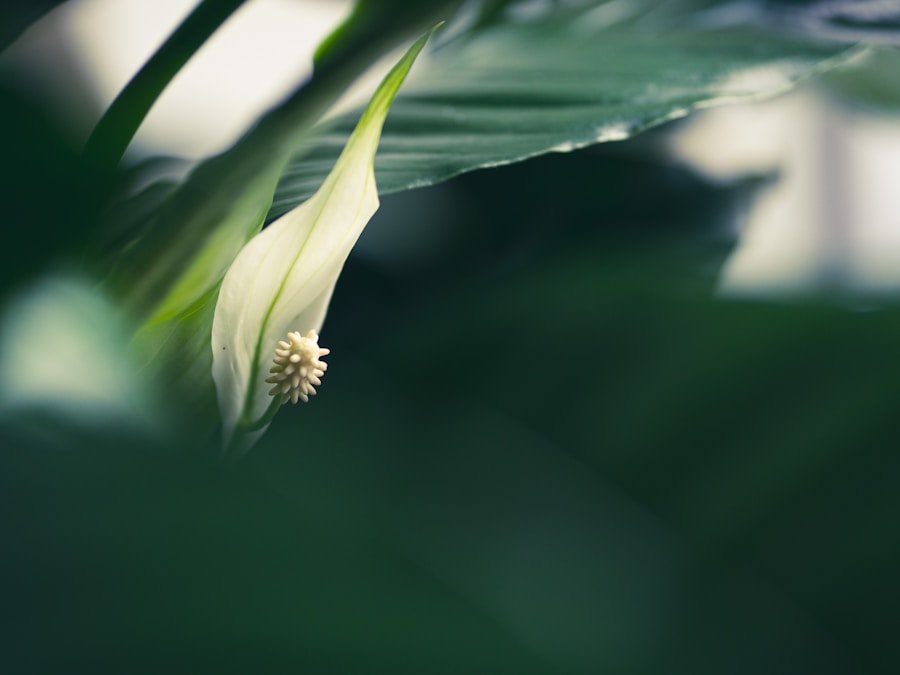When harvesting leafy greens and herbs, it is essential to consider the plant’s growth stage, as different varieties have optimal harvesting times. For instance, lettuce is typically harvested when the leaves are young and tender, whereas kale can be harvested at various stages depending on personal preference. To determine the growth stage, closely monitor the development of leaves and stems.
For leafy greens, look for the formation of a rosette or the appearance of new leaves. For herbs, observe the development of flowers or the overall size of the plant. Another method to assess the growth stage is to examine the plant’s overall appearance.
Check for signs of wilting or yellowing, which can indicate that the plant is past its prime for harvesting. Additionally, keep track of the number of days since planting or transplanting, as this can provide a good indication of when the plant is likely to be ready for harvest.
Key Takeaways
- Observing the Growth Stage: Look for mature leaves and a full, bushy appearance before harvesting leafy greens and herbs.
- Checking for Size and Color: Harvest when the leaves are at their peak size and color, indicating maximum flavor and nutrients.
- Assessing Leaf Texture: Choose leaves that are tender and not tough or woody for the best eating quality.
- Monitoring for Bolting: Harvest before the plants start to bolt, or produce flowers and seeds, as this can make the leaves bitter.
- Smelling and Tasting for Flavor: Use your senses to determine the best time for harvesting, as herbs and greens should have a strong aroma and vibrant flavor.
Checking for Size and Color
Determining the Readiness of Leafy Greens and Herbs for Harvest
Size as an Indicator of Readiness
When it comes to leafy greens, such as spinach and lettuce, the size of the leaves can be a good indicator of when they are ready to be harvested. Generally, smaller leaves are more tender and flavorful, while larger leaves may be tougher and more bitter. Similarly, herbs like basil and cilantro are often best harvested when they are still young and tender, before they have a chance to become woody or develop a strong flavor.
Color as an Indicator of Readiness
Color can also be a helpful indicator of when leafy greens and herbs are ready to be harvested. For example, lettuce is typically best harvested when the leaves are a vibrant green color, while kale is often at its peak when the leaves are a deep, dark green. Similarly, herbs like parsley and mint are often best harvested when their leaves are a bright, healthy green color.
Regular Visual Inspection
Checking for size and color can be done by visually inspecting the plants on a regular basis and comparing them to reference images or descriptions of what they should look like when ready for harvest. By doing so, you can ensure that you harvest your leafy greens and herbs at the optimal time, resulting in the best flavor and texture.
Assessing Leaf Texture
Another important factor to consider when determining if leafy greens and herbs are ready to be harvested is their texture. The texture of the leaves can give valuable insight into their readiness for harvest. For example, lettuce leaves that are young and tender will have a crisp, succulent texture, while older leaves may be tougher and more fibrous.
Similarly, herbs like cilantro and dill are best harvested when their leaves are soft and pliable, rather than tough and leathery. Assessing leaf texture can be done by gently touching and feeling the leaves of the plants. This can help determine if they are at their peak tenderness or if they have become too tough for optimal flavor and texture.
Additionally, assessing leaf texture can involve tasting a small sample of the leaves to determine if they have the desired texture and flavor. This can be a helpful way to ensure that leafy greens and herbs are harvested at their peak quality.
Monitoring for Bolting
| Indicator | Leafy Greens | Herbs |
|---|---|---|
| Size | Leaves are full-sized and mature | Plants are bushy and have abundant leaves |
| Color | Leaves are vibrant and green | Leaves are aromatic and green |
| Texture | Leaves are crisp and tender | Leaves are fragrant and tender |
| Time | Usually ready within 4-6 weeks after planting | Ready for harvest when they reach desired size |
Bolting is a natural process that occurs in many leafy greens and herbs as they reach the end of their life cycle. It involves the rapid growth of a flowering stalk, which can cause the leaves to become bitter and tough. Monitoring for bolting is an important part of determining when leafy greens and herbs are ready to be harvested.
This can be done by keeping an eye out for the formation of flower buds or stalks on the plants. Additionally, monitoring for bolting may involve paying attention to changes in the flavor and texture of the leaves, as these can be indicators that bolting is occurring. Preventing bolting can be done by harvesting leafy greens and herbs before they reach this stage in their growth cycle.
This may involve harvesting them earlier than usual or using techniques such as providing shade or cooler temperatures to delay the onset of bolting. By monitoring for bolting and taking steps to prevent it, it is possible to ensure that leafy greens and herbs are harvested at their peak quality.
Smelling and Tasting for Flavor
One of the most reliable ways to determine if leafy greens and herbs are ready to be harvested is by smelling and tasting them for flavor. The aroma and taste of leafy greens and herbs can provide valuable information about their readiness for harvest. For example, lettuce that is at its peak will have a fresh, clean aroma and a mild, slightly sweet flavor.
On the other hand, lettuce that is past its prime may have a bitter or off-putting taste. Similarly, herbs like basil and mint are often best harvested when they have a strong, aromatic scent and a bold, fresh flavor. Smelling and tasting leafy greens and herbs can be done by plucking a small sample from the plant and taking note of their aroma and flavor.
This can help determine if they are at their peak quality or if they need more time to develop their full flavor profile.
Considering the Weather Conditions
Temperature and Sunlight Effects
Leafy greens like spinach and arugula may become bitter and tough if exposed to high temperatures or prolonged sunlight. Similarly, herbs like cilantro and parsley may wilt or lose their flavor if subjected to excessive heat or dry conditions.
Monitoring and Protecting the Plants
Considering the weather conditions when determining if leafy greens and herbs are ready to be harvested involves monitoring the forecast for any extreme conditions that may affect the plants. It may also involve taking steps to protect the plants from adverse weather, such as providing shade or extra water during hot, dry periods.
Harvesting at Peak Quality
By considering the weather conditions, it is possible to ensure that leafy greens and herbs are harvested at their peak quality.
Using Harvesting Tools and Techniques
When it comes time to harvest leafy greens and herbs, using the right tools and techniques can make a big difference in preserving their quality. For leafy greens like lettuce and kale, using sharp scissors or shears can help prevent damage to the plants while harvesting. This can help ensure that the leaves remain fresh and crisp after being cut from the plant.
Similarly, for herbs like basil and cilantro, using a sharp knife or scissors can help prevent bruising or crushing of the delicate leaves. In addition to using the right tools, using proper harvesting techniques can also help preserve the quality of leafy greens and herbs. This may involve harvesting them in the early morning or late evening when temperatures are cooler, as this can help prevent wilting or damage to the leaves.
It may also involve handling the plants gently and avoiding excessive handling or rough treatment during harvesting. By using harvesting tools and techniques that prioritize gentle handling and preservation of quality, it is possible to ensure that leafy greens and herbs are harvested at their peak freshness. In conclusion, knowing when leafy greens and herbs are ready to be harvested involves a combination of observation, assessment, and consideration of various factors.
By closely monitoring the growth stage, size, color, texture, bolting, flavor, weather conditions, and using proper tools and techniques for harvesting, it is possible to ensure that these plants are harvested at their peak quality. Whether you are growing your own leafy greens and herbs in a garden or purchasing them from a local market, understanding these indicators of readiness for harvest can help you enjoy these delicious and nutritious plants at their best.
FAQs
What are some common signs that leafy greens and herbs are ready to be harvested?
Some common signs that leafy greens and herbs are ready to be harvested include mature leaf size, vibrant color, and a strong aroma. For leafy greens, you can also look for the outer leaves to be large enough to harvest without damaging the plant.
How do I know when to harvest leafy greens and herbs for the best flavor?
For the best flavor, it’s recommended to harvest leafy greens and herbs in the morning when their flavors are most concentrated. Additionally, harvesting leafy greens and herbs before they flower can help maintain their flavor.
What is the best way to harvest leafy greens and herbs to ensure continued growth?
To ensure continued growth, it’s best to harvest leafy greens and herbs by cutting the outer leaves or stems, leaving the inner leaves or central growth point intact. This allows the plant to continue producing new growth.
Are there any specific techniques for harvesting different types of leafy greens and herbs?
Yes, there are specific techniques for harvesting different types of leafy greens and herbs. For example, for leafy greens like lettuce and spinach, you can use a “cut and come again” method where you harvest outer leaves while allowing the inner leaves to continue growing. For herbs like basil and cilantro, it’s best to harvest the top leaves to encourage bushier growth.
What should I do with harvested leafy greens and herbs?
After harvesting leafy greens and herbs, it’s best to wash them thoroughly to remove any dirt or debris. Once cleaned, they can be used immediately in recipes, stored in the refrigerator for a few days, or preserved by drying or freezing for longer-term use.





